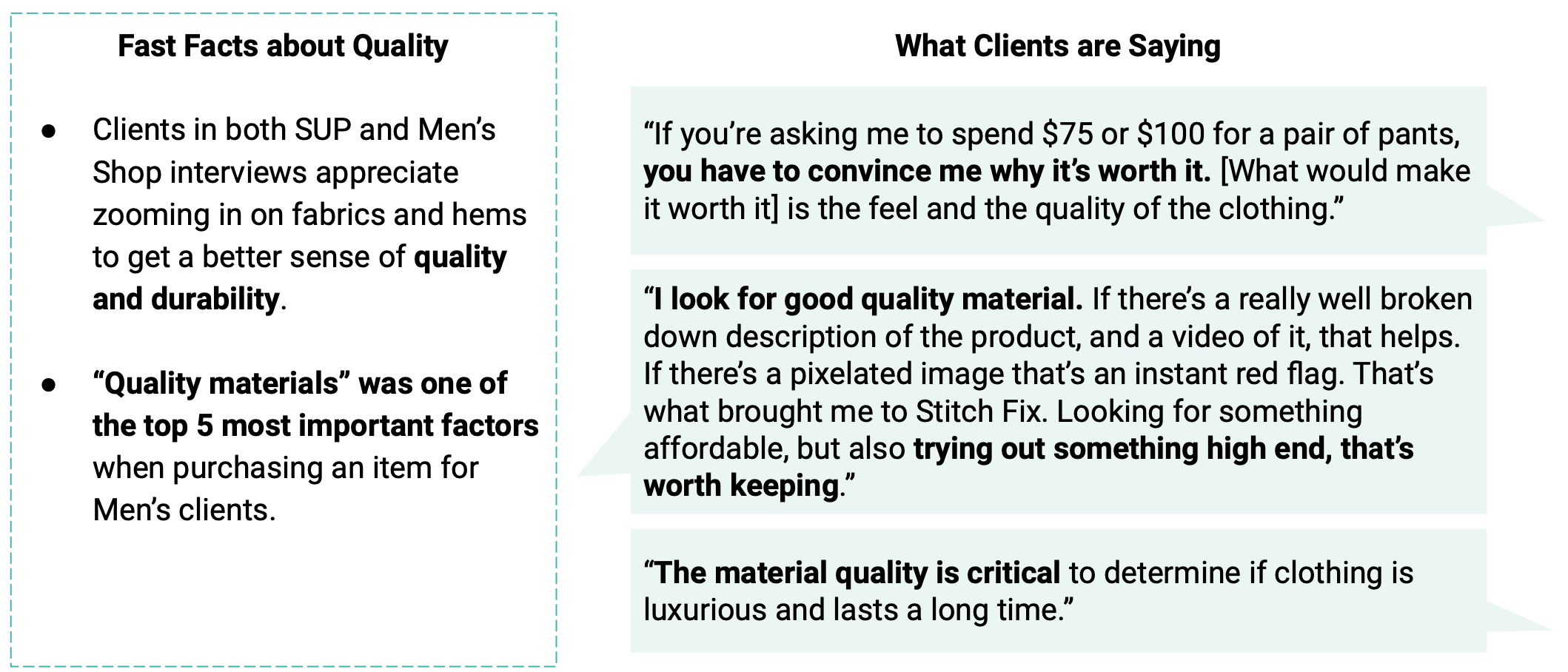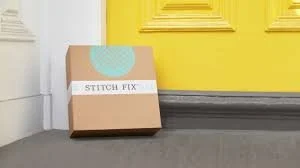Stitch Fix Product Detail Page
In 2021, Stitch Fix expanded beyond their styled Fix box offering into personalized shopping, aka Freestyle. With personalized shopping, customers can directly shop algorithmically-curated merchandise based on their style, fit, and closet of Stitch Fix kept items. As the principal designer and manager of the Conversion team, I led my team in taking the product detail page (PDP) to the next level, by boosting customers’ confidence that the item in question is perfect for them.
Skills
UX design, product strategy, UX research, agile development, management
Research
I collaborated closely with a senior user researcher to conduct studies on what people needed most from the PDP. We had participants walk through the process of shopping on Stitch Fix, and voice over their experience of the original PDP. They talked through their thoughts as they assessed the item.
The original PDP didn’t take advantage of the rich data we could use to personalize the customer’s experience. There wasn’t much to go on if you looked at this page and decided these leggings weren’t for you.
We went through all the videos and pulled out the key themes to shape our strategy.
The feedback really hit home just how important it was to build confidence that the item would fit. Fit is about not just getting the right size, but how an item will hang, hug, or flatter a person’s shape:
It was Stitch Fix’s job to fill in our customers’ imagination of how they will look wearing any item, and how to pull together multiple stylish looks:
Quality is the determining factor in whether it’s worth it to spend the money on another item of clothing. It’s also one of the most difficult things to convey digitally:
Strategy
The researcher, product manager, and I summarized the customer needs we identified from the research into key themes, and created a robust strategy around how to provide fit, style, and quality confidence. This strategy guided our roadmap. We tested each of the enhancements and tracked metrics such as the PDP-to-submit-order rate, basket size, average order value, and return rates.
With each enhancement, we strove to personalize all aspects of the PDP and tap into our strongest assets (client feedback and interaction data, our stylist community, and algorithmically-powered styling capabilities such as outfits).
I designed the PDP to showcase how the item can be worn with other items the customer has kept from Stitch Fix (algorithmically-curated outfits). My engineering team, the marketing team, and I boosted customers’ confidence that the item will fit them by including high-quality imagery from different angles of the clothing on models. This imagery shows details that help customers get a sense for the clothing’s quality and how it will hang on your body. It was also designed to show how the clothing would fit on differently sized models. My team and I explored bringing in stylist or merchandiser knowledge of the clothing’s hand feel or styling possibilities. We also extensively explored different ways of using social proof to build confidence in the clothing.
Design
To carry out the PDP strategy, I designed and tested multiple concepts that addressed customers’ biggest needs out of the PDP.
Style Confidence
“Show me the possibilities before I buy.”
Our research on visitors (not yet customers) revealed that people without a strong style identity were second guessing the purchase as it sat in the cart. These visitors had difficulty defining their style. Furthermore, research showed that for men in particular, item versatility is one of the most important factors before purchase.
This prototype demonstrated how our personalization capabilities can showcase themed outfits anchored on an item. This helps customers see the versatility of an item and receive styling guidance without ordering a styled Fix box.
Fit Confidence
“I want to feel confident in the size, fit and quality of the item prior to purchasing it.”
72% of men looked to fit as the most important criteria when buying apparel. 16% of customers submitting feedback through the live site requested details on the apparel that would improve their confidence in size, fit, and quality, such as a size chart or more imagery.
We learned from an on-figure imagery experiment that customers really need to see clothing on a human body to drive confidence in fit. They not only want to see how it would look on a model’s body but how it will work on their own body shape. With our personalization abilities, customers expect us to express how an item will fit on them.
We explored creating short-form videos or blurbs by stylists to express hand feel, stretch, and fabric. We partnered with the Creative team to increase coverage of multiple angles of items to display more zoomed-in details of the stitching, knit, and details.
Due to cost and the associated ROI, as well as limitations in the data we possessed, we landed on a PDP that provided detailed, varied imagery of the item on a model, size and height info, sizing labels, and a size chart.
Pathways to Prevent Dead Ends
“I’m looking to discover new items if this one isn’t right for me or not available at that moment”
The PDP-to-submit-order rate was previously 16-18%. The item either didn’t resonate for the customer, or was out of stock in their desired size and color. We offered personalized pathways to finding the right merchandise without introducing friction, by introducing similar items, more from the brand, and cross selling to relevant categories, such as wide-legged pants for crop tops. We also explored adding a community element such as ‘Clients like you also bought’.
Social Proof
“I need to hear what other people like me think.”
We had compelling data showing that the vast majority of online shoppers need some sort of social proof to make a purchase decision. Shoppers look to reviews, tags, stars, and other indicators from others like them (e.g. ‘busty’, ‘pear shaped’, 5’4”) to validate their decision. With our wealth of customer feedback from Fixes, we had the opportunity to thoughtfully and respectfully consider leveraging this feedback in our own way without adding too much noise. I explored a few concepts that would pull out the key information people needed, without compromising private information that was given as feedback through Fixes.
Impact
The PDP evolved under this roadmap to a full-featured destination in the shopping journey where customers find themselves increasingly confident and excited to buy from Stitch Fix. They can easily see themselves rocking the look in all sorts of situations. They can justify the purchase because they’re confident the merchandise is good quality and will flatter them.
Customers who decide the item isn’t right for them can quickly branch off from what used to be a dull dead end to an inspiring world of similar styles or more from the same brand. With each new enhancement to the PDP, we tracked increased revenue and items sold, and reduced returns.
Next Project:












